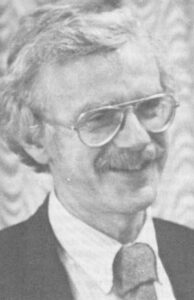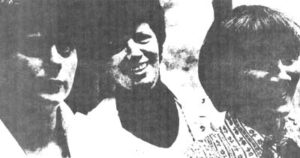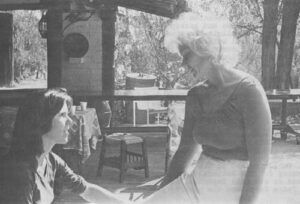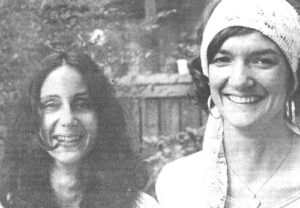This country’s health problems are not going to be solved by throwing big money into cures with a pittance to prevention, by producing more doctors, hospitals and drugs. We’d do better to get people to change their health habits and the unhealthy environments in which they live. The Swedish and Chinese people have turned their countries into healthier places. Certainly the U.S. can too.
Leon White, engineering PhD at Harvard School of Public Health warned me: “The major problem with changing lifestyles for a healthy people is that it is not clear that the public goal is to live as long and as healthy a life as we may think they want to.” White is directing a Cooperative Health Improvement Program in Boston suburbs by selling lifestyle changes. “We assume they want to live longer and be well more of the time. It is clear they don’t want to get hit by a car or get cancer, but ask them to cut out smoking in public places and they yell like hell for their freedom. And they won’t put on seat belts,” he said.
He said that talking to the poor about health is whistling in the dark because the immediate problems outweigh long term ones. He said his program focuses on children ten to fifteen, a time when behavior is created and not yet entrenched. The program includes getting them involved in lifetime rather than competitive sports and having them become aware of the link between diet and heart disease.
Lifestyles is the buzzword, which describes how people handle smoking, driving and seat belts, drug abuse, sloth, eating and alcohol.
In Canada, National Health and Welfare’s program Operation Lifestyle defines it this way: “Lifestyle is the unique pattern of your daily life. It is neither sickness nor health. It is the food you eat, the weight problem, the malnutrition, the balanced diet. Lifestyle is the cars you drive and the seat belts you don’t wear. It’s speeding or taking it easy. It’s the alcohol you drink!!”
William L. Lane, director of Bon Secours Hospital in a suburb north of Boston, commented, “If the people really want to spend less on health care they can cut the cost by 60 percent if they are willing to change lifestyles. A smoker uses health care services three times as much as a non-smoker, and has 80 percent of surgery complications. Eighteen percent of all hospital admissions are related to smoking.”
Dr. John Knowles, head of the Rockefeller Foundation, puts it another way: “The next major advances in the health of the American people will result from the assumption of individual responsibility for one’s own health. This will require a change in lifestyle for the majority of Americans. The cost of sloth, gluttony, alcoholic overuse, reckless driving, sexual intemperance and smoking is now a national, not an individual responsibility.”
Knowles has been criticized for omitting social responsibility, the role of advertising in the food industry encouraging poor nutrition, health care for the poor, and pollution.
I agree with John McKnight of the Center for Urban Affairs at Northwestern University who said medicine affirms loneliness and that health is a political issue requiring corporate action. “Justice, equity, and a mutual system of belief are the keys to a healthy community, not more doctors and police,” he said. The real health problems I saw in a Chicago ghetto was joblessness; 40 per cent of youth there were unemployed and 28 per cent of the adults.
There was no way the three bullets in the treatment gun of traditional medicine-drugs, surgery and psychotherapy were going to do anything but miss the mark in that community. “Many people here feel no purpose in life and lack self-worth,” said Clay Collier, director of health action for the Christian Action Ministry, an organization which had worked with McKnight. For Collier the key to building a healthy community was not to add doctors and police. Instead, he built rooftop vegetable gardens and coordinated residents to collect wild dogs in a heavy dog-bite area-both moves improving a sense of community.
In Canada, in the early 1970’s, National Health and Welfare funded Participation to sell fitness as if it were a new kind of soft drink. The former president of the agency, Keith B. McKerracher, 49, is a marketing and advertising expert who has exported similar agencies to other countries and is negotiating to start one in the U.S.
He pronounces the U.S. in a state of “fitness readiness,” meaning Americans are ready to get fit. They are off to a good motivational start, he said, because they know they are unfit. Canadians were under the illusion they were the “Strong People of the North”, inheritors of the brawn of fur trappers, when in fact they were among the most unfit people in the world. Marketing techniques spread the word that the fitness of the average 30-year old Canadian equaled that of a 60-year old Swede. You have to accept how badly off you are before you can be motivated to change.
McKerracher said the novel thing about Participation is that it is run by communications people. Sports people were miffed that something involving physical activity should be run by any one other than a coach or former coach. “Sports people have a myopic view that everyone has been into sports at one time,” he said. “They have never run around with stumblebums. I believe most of us have never been successful in athletics so when I hear a TV commercial that says, ‘Hey, get back into this kind of life,’ it is not addressed to me. I represent 80 per cent of the people and the sports approach aims at only a narrow band. The Participation theme is, ‘If you felt you didn’t make it, we understand you.”
He said the approach is gentle. The first step in the new fit life may be putting away the TV remote control channel switcher and getting up to cross the room three times a night. “Then we ask you to think before you go to bed, to walk around the block the next day, rain or shine and create a habit pattern.”
On Feb. 5, 1973 “an experiment in mass walks around the block was tried in the Saskatchewan community of Saskatoon. At 7:30 in the evening church bells rang and 70,000 of the town’s 125,000 persons walked around their block in 26 below zero cold. “It was not enough to change the body,” said McKerracher, “but it acted like a placebo and changed their heads and gave them a feeling of self-worth. Their accomplishment is as important as that of the guy who used to be on the track team going back to running five miles. The non-athlete never had any kudos so Participation gives him kudos if he moves.”
Saskatoon continued adding collective walking distance until, combined, it circled the world several times. They even challenged Umea, a town in northern Sweden, in May 1975 to see how many citizens would walk two kilometers on each of three successive days. Saskatoon won. More than 70 different groups such as firefighters issued individual challenges and the ambassadors to the two countries were present at ceremonies.
McKerracher said that walkathons for charity in Toronto drew only 70,000 out of three million. He believes the charity advertising appeals only to the sports-minded who are 10 per cent of the public, failing to attract the broad spectrum reached in Saskatoon. He said advertising using models who are out of shape instead of sleek sports stars, is far more effective in involving the average person. He said Participation was so effective that he had pressure to use its well-accepted name to teach nutrition, combat alcoholism and smoking and other health problems. However, fun is the main goal of Participation and McKerracher felt if he took on other issues the name and image of the agency would suffer severely.

Robert Buxbaum, 47-year-old Harvard Community Health Plan internist and enthusiast of Sweden’s national fitness and health program, would like to see a political candidate stand on the issues of fitness. Buxbaum is chairman of the Governor’s Committee on Fitness and Sport in Massachusetts.
He said Sweden pushed federal fitness programs in the 1950’s until there are no fat Swedes today. “But I was shocked on my return flight to this country to see so many obese people,” he said.
Buxbaum swims for fitness. He said that instead of hockey rinks the Swedes favor swimming pools. The building costs of pools and rinks are nearly equal but the cost per use of pools is lower than rinks because tots to 80-year-olds can use pools. He said in Sweden it is the job of the local recreation departments to keep people fit and that they work closely with the Swedish sport federation. In the U.S., agencies to control smoking, drinking, drugs and different diseases work separately and the big sports teams have little tie with local recreation.
The Swedish motto is “Eat what you want, but burn it off for God’s sake.” Buxbaum said, “I feel that once you get someone to run or swim he will cut down on eating.”
He pointed to a map of Stockholm extending his index along a network of red, winding trails through the woods about 20 kilometers outside the city. There were jogging and ski trails as long as 15 miles dotted with places to change clothes and shower. They were covered with a sand surface to soften impact on the foot and knee and reduce injuries.
I recalled the great snowstorm of February 1978, which halted auto traffic in the Northeast for nearly a week forcing people to walk and encouraging them to have chance encounters with each other. The environment encourages fitness, and movement and snow provided a fine environment until cars returned.
Buxbaum said that Swedes feet exercise should be life long, that men, women and children should take part, that it promote health and be fun. It’s the motion that counts, not the strain.
The U.S. is underdeveloped when it comes to fitness. People in the work place are sedentary for eight hours a day. Sweden has morning and afternoon exercise breaks while in the U.S. it has to be proven to managers that exercise pays off in lower absenteeism and better morale.
If exercise is not enjoyable, it won’t work. Buxbaum said two major oil companies have a grim circuit-training course with a physiologist staring at the exercising employee through the glass. “The program has a high dropout rate with only the confirmed jocks hanging on,” he said.
I was delighted that Canadians picked advertising men to sell fitness. What would happen in this country if Madison Avenue were harnessed to promote health instead of sugared breakfast cereals and deodorants?
©1978 Philip Weld, Jr.
Philip Weld, Jr. is spending his fellowship year writing about the “Role of Self Care in Health.”







